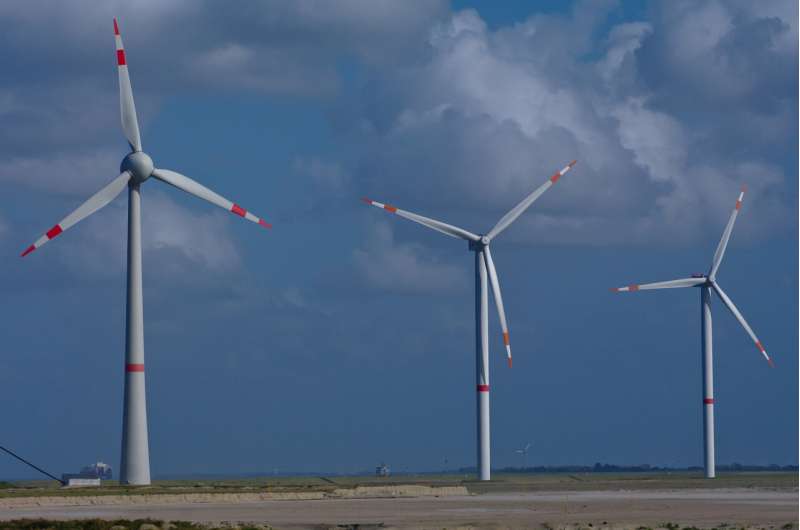Researchers propose a circular economy for rare-earth elements

Rare-earth elements (REEs) are found in smartphones, plasma screens and even artificial joints. As components of wind turbines or electric motors, they play an important role in the production of clean energy. The battle for these valuable resources is already in full swing.
In a Comment published in the journal Nature, researchers from Germany, China and the U.S. show new ways to get a circular economy for REEs off the ground. Raimund Bleischwitz, an expert in circular economy at ZMT in Bremen, is one of the authors. He says, “In order to meet the increasing demand without harming the environment, the entire REE industry needs to be rethought.”
The demand for REEs has been rising for years. According to forecasts, global use of these elements will probably increase fivefold—from about 60,000 tons in 2005 to 315,000 tons in 2030. If the energy transition is to succeed, REEs are needed—for example, about 170 kilograms of the REEs are required to generate one megawatt of wind-powered energy.
At the same time, REEs are not freely available. More than half (56%) of the world’s reserves and over three quarters (76%) of production are controlled by the three major powers China, the U.S. and Russia.
Green industries in the United States and Europe are facing shortages of these important materials as they forgo Chinese and Russian exports. The U.S. and EU have classified REEs as critical raw materials.
In the competition for these resources, even the ocean floor is now coming into focus, as seen in the current negotiations on deep-sea mining.
“There is a geopolitical race for control of REEs. Countries are trying to squeeze each other out,” says Professor Raimund Bleischwitz of ZMT. “The REE market is currently a zero-sum game, where gains for one nation mean losses for another, with no benefit for the general public.”
Many countries promote the search for rare earths and mining in their own countries while at the same time restricting export opportunities, Bleischwitz says.
Moreover, the processing of REEs is increasingly damaging to the environment as the value chain consumes large amounts of energy and water and releases pollutants and carbon emissions. “According to a U.S. study, refining one ton of REE oxide can produce not only 1.4 tons of radioactive waste, but also 2,000 tons of waste material and 1,000 tons of wastewater containing heavy metals,” Bleischwitz says.
Only about 1% of REEs are recycled
Meanwhile, only about 1% of REEs are currently recycled, as there are no policies or programs anywhere in the world for recycling REEs from products. Many devices that contain REEs in relatively high concentrations, such as batteries in electric cars and magnets in wind turbines, are still in use and years away from being retired.
Together with renowned colleagues from China and the U.S., Raimund Bleischwitz, an expert in circular economy at ZMT, has now come up with ideas how to fuel the global REE recycling thus possibly taking the heat out of the geopolitical race and conserving resources.
In their article in Nature, the scientists show concrete examples of implementation, weigh the pros and cons and make a case for investment in research and innovative recycling technologies. Bleischwitz and his colleagues identify three overarching options for action and describe detailed measures for which they see politicians and governments worldwide in a role to act.
“Circular economy policies and practices can overcome the zero-sum mentality,” Bleischwitz says. “Agreement on such issues, for example at the next G20 meeting in New Delhi in September, could revitalize international trade and expand global partnerships for the energy transition.”
“Low- and middle-income countries could also gain access to REEs in this way to accelerate their energy transition. We need to stop illegal mining and trade, which often enough takes place in the Global South. An important incentive for better circular economy, also for critical materials like rare earths, would also be a moratorium on deep-sea mining,” Bleischwitz says.
More information:
Yong Geng et al, How to build a circular economy for rare-earth elements, Nature (2023). DOI: 10.1038/d41586-023-02153-z
Provided by
Leibniz-Zentrum für Marine Tropenforschung (ZMT)
Citation:
Researchers propose a circular economy for rare-earth elements (2023, July 18)
retrieved 18 July 2023
from https://techxplore.com/news/2023-07-circular-economy-rare-earth-elements.html
This document is subject to copyright. Apart from any fair dealing for the purpose of private study or research, no
part may be reproduced without the written permission. The content is provided for information purposes only.
For all the latest business News Click Here

